The cocktail before you tasted wonderful when the bartender first made it. Now it’s fading, getting weaker, watery, losing its appeal. The ice is melting and diluting it to a shadow of its former self. Time to order another but, sadly, soon that one will do the same thing. It’s entropy at work, the eventual decline of everything into disorder.
But rescue is at hand. In Geometry and the Imagination, mathematicians David Hilbert and Stephan Cohn-Vossen define 11 properties of a sphere, #7 being: “Of all solids having a given volume, the sphere is the one with the smallest surface area; of all solids having a given surface area, the sphere is the one having the greatest volume.” So, cocktail aficionados, with an ice ball in your drink instead of ice cubes you’ll get maximum cooling and minimum melting. Ain’t science grand?
THE ICE BALL PRESS
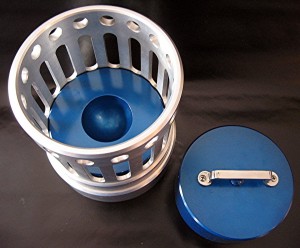 Inventors and manufacturers have taken note and made a variety of devices available. Most consist of a large cylinder of aluminum with a hemispheric indentation on which you place a chunk of ice. Place a similar aluminum piece on top and its weight and temperature melt excess ice away creating a 2.5-inch ice ball in about a minute. The only problem: it costs $800. But, if you have a daughter enrolled in metal shop class like I do, she’ll make you one for Christmas.
Inventors and manufacturers have taken note and made a variety of devices available. Most consist of a large cylinder of aluminum with a hemispheric indentation on which you place a chunk of ice. Place a similar aluminum piece on top and its weight and temperature melt excess ice away creating a 2.5-inch ice ball in about a minute. The only problem: it costs $800. But, if you have a daughter enrolled in metal shop class like I do, she’ll make you one for Christmas.
The matter doesn’t come to rest there, however. An ice ball must be clear 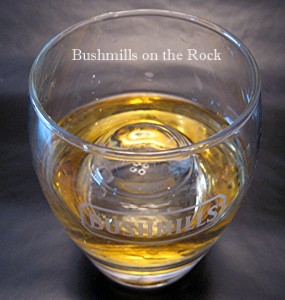 or nearly so to be aesthetically pleasing. It should offer a clear window into the drink instead of calling attention to itself. For example: “Bushmills on the Rock.”
or nearly so to be aesthetically pleasing. It should offer a clear window into the drink instead of calling attention to itself. For example: “Bushmills on the Rock.”
To accomplish this fill small cylindrical containers with water, place them in a picnic cooler nearly full of water, and freeze the entire container for about five days. Surrounded by gradually freezing water, the small containers solidify slowly and allow air bubbles to escape instead of being captured in the ice. Chip containers from the frozen cooler and use the ice cylinders in them in the press. A simpler solution is to buy a block of clear ice somewhere and cut it into chunks with a circular saw.
TO ABSURDITY AND BEYOND
This leads to other possibilities. A clear ice ball could be a source of interest or amusement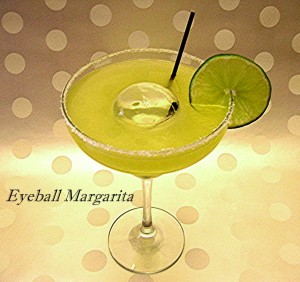 in a cocktail. Consider the “Eyeball Margarita.” Make one and soon everyone at the bar will want one. But soon they’ll fall silent for, as Friedrich Nietzsche said, if you gaze into the abyss the abyss gazes also into you.
in a cocktail. Consider the “Eyeball Margarita.” Make one and soon everyone at the bar will want one. But soon they’ll fall silent for, as Friedrich Nietzsche said, if you gaze into the abyss the abyss gazes also into you.
Why stop there? Wouldn’t making ice balls from fruit juice dress up a drink? Melting would release no water at all.
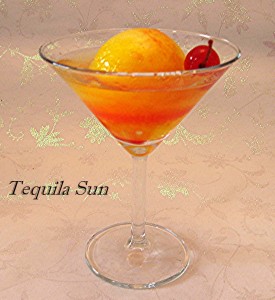 Results from this experiment were mixed. A frozen ball of orange juice works well in a Tequila Sunrise, especially since you can keep adding tequila as it melts.
Results from this experiment were mixed. A frozen ball of orange juice works well in a Tequila Sunrise, especially since you can keep adding tequila as it melts.
But in a Daiquiri a frozen lime juice ball doesn’t work at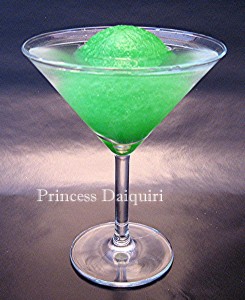 all. Lime is essential to the Daiquiri’s taste; lock it up in a frozen ball and all you taste is rum. Results are similar with pineapple and cranberry juice. The resulting cocktails are eye-catching and can be given clever names, but they taste awful. Better stick with freezing water into clear balls of ice.
all. Lime is essential to the Daiquiri’s taste; lock it up in a frozen ball and all you taste is rum. Results are similar with pineapple and cranberry juice. The resulting cocktails are eye-catching and can be given clever names, but they taste awful. Better stick with freezing water into clear balls of ice.
_______________
Ice ball press designed and built by Kyra Carson.
